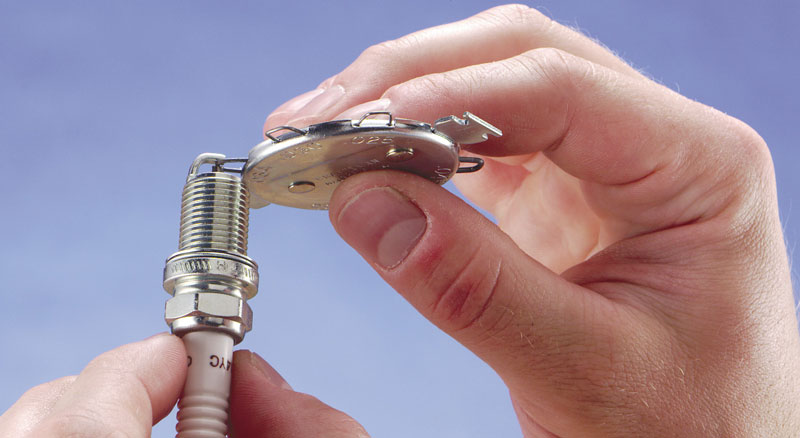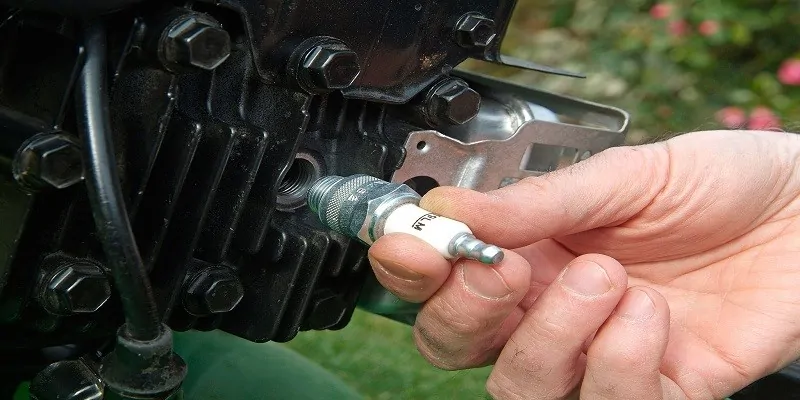Last Updated on January 15, 2025
To remove a lawn mower spark plug, first, disconnect the spark plug wire and use a spark plug wrench to loosen and remove the plug. When it comes to lawn mower maintenance, knowing how to remove a spark plug is essential.
Whether you need to replace a faulty plug or perform regular cleaning, this task is relatively simple. By following a few steps, you can remove the spark plug and ensure the optimal performance of your lawn mower. We will provide step-by-step instructions on how to remove a lawn mower spark plug, along with some maintenance tips.
The Importance Of Spark Plug Maintenance
Understand the importance of spark plug maintenance to keep your lawn mower running smoothly. Here’s how to remove a spark plug to ensure optimal performance.
Regular maintenance of your lawn mower’s spark plug is crucial for ensuring smooth and efficient operation. Ignoring spark plug maintenance can lead to various issues such as poor performance, reduced fuel efficiency, and even engine damage. In this section, we will explore the importance of regular spark plug maintenance and the signs that indicate a faulty spark plug.
Importance Of Regular Spark Plug Maintenance:
Maintaining your lawn mower’s spark plug is essential for the following reasons:
- Optimal engine performance: The spark plug is responsible for igniting the fuel-air mixture in the engine’s combustion chamber. A well-maintained spark plug ensures proper combustion, leading to smooth and efficient engine performance.
- Improved fuel efficiency: A properly functioning spark plug ignites the fuel-air mixture effectively, maximizing fuel combustion. This helps in achieving better fuel efficiency, resulting in cost savings over time.
- Prevention of engine misfires: Over time, spark plugs can become worn out or covered in deposits, affecting their ability to produce a consistent and strong spark. This can lead to engine misfires, causing rough idling and reduced power output. Regular spark plug maintenance helps prevent such issues.
- Extended engine life: By regularly inspecting and replacing spark plugs when necessary, you can minimize the risk of engine damage. Faulty spark plugs can cause incomplete combustion, increasing the likelihood of unburned fuel residue accumulating in the engine. This could potentially lead to costly repairs or even the need for engine replacement.
Signs of a faulty spark plug:
It’s important to be aware of the signs that indicate a potential problem with your lawn mower’s spark plug. Look out for the following signs:
- Difficult starting: If your lawn mower is becoming increasingly difficult to start or requires multiple attempts to start, it could be due to a faulty spark plug. A worn-out spark plug may struggle to provide a strong spark, hindering the combustion process.
- Rough or uneven engine performance: A spark plug that is misfiring can cause the engine to run unevenly, resulting in vibrations or a rough running sensation. This can lead to reduced power output and overall poor performance.
- Increased fuel consumption: If you notice a sudden increase in fuel consumption without any other apparent changes or issues, a faulty spark plug could be at fault. Inefficient combustion caused by a worn-out spark plug can result in higher fuel consumption.
- Blackened or fouled spark plug: Inspecting the spark plug regularly can reveal valuable information about its condition. If the spark plug electrode is blackened or covered in carbon deposits, it indicates incomplete combustion and a need for cleaning or replacement.
By understanding the importance of regular spark plug maintenance and being aware of the signs that indicate a faulty spark plug, you can ensure the optimal performance and longevity of your lawn mower. Regularly inspecting and replacing spark plugs when necessary will keep your mower running smoothly and efficiently, ultimately saving you time and money in the long run.
Preparing To Remove The Spark Plug
To prepare to remove the spark plug on your lawn mower, ensure the engine is cool and disconnect the spark plug wire. Loosen the plug with a wrench, then remove it by hand and inspect it for damage or wear.
Before you start removing the spark plug from your lawn mower, it’s important to gather the necessary tools and ensure that safety precautions are in place. By following these steps, you can effectively remove the spark plug without any issues.
Gathering The Necessary Tools:
- Socket wrench: This tool will help you remove the spark plug from its socket.
- Spark plug socket: A specialized socket designed specifically for spark plugs.
- Rag or towel: Use this to clean the area around the spark plug before removal.
- Spark plug gap gauge: This gauge will help you check and adjust the gap of the new spark plug.
- Penetrating oil: Helpful for loosening any stuck or rusty spark plugs.
- Safety goggles: Protect your eyes from any debris during the removal process.
- Gloves: Keep your hands safe while working with the spark plug.
Ensuring Safety Precautions:
- Disconnect the spark plug wire: Before removing the spark plug, always disconnect the spark plug wire to prevent accidental ignition.
- Allow the engine to cool: Make sure the engine has cooled down completely before attempting to remove the spark plug. This will prevent any burns or injuries.
- Clean the surrounding area: Remove any debris or dirt covering the spark plug area to avoid it falling into the cylinder when removing the spark plug.
- Secure the mower: If the lawn mower is gasoline-powered, make sure to disconnect the fuel source or secure the fuel cap tightly. This will prevent any accidental fuel leaks or spills during the process.
- Follow manufacturer instructions: Refer to your lawn mower’s manual for specific instructions on removing the spark plug. Different models may have different requirements.
Now that you have gathered the necessary tools and ensured safety precautions, you are ready to move on to the next steps of removing the spark plug. Stay tuned for the next section where we will guide you through the step-by-step process.
Step-By-Step Guide To Removing A Lawn Mower Spark Plug
Learn how to remove a lawn mower spark plug with this comprehensive step-by-step guide. With easy-to-follow instructions, you’ll be able to safely remove and replace your spark plug in no time, keeping your mower running smoothly.
Step 1: Disconnecting The Spark Plug Wire
- Start by ensuring your lawn mower is turned off and the engine is completely cooled down.
- Locate the spark plug wire, which is typically a thick, rubber-coated wire connected to the spark plug.
- Grip the spark plug wire firmly near the base and carefully pull it straight off the spark plug. Be sure to avoid any contact with the spark plug itself.
- By disconnecting the spark plug wire, you will prevent accidental engine starts during the removal process.
Step 2: Removing Debris Around The Spark Plug
- Inspect the area around the spark plug for any grass, dirt, or debris that may have accumulated.
- Use a small brush or compressed air to gently clean the area, ensuring that no debris falls into the spark plug well.
- Removing debris will prevent it from interfering with the proper removal and installation of the spark plug.
Step 3: Loosening The Spark Plug Using A Socket Wrench
- Select a spark plug socket that fits the size of your mower’s spark plug. Common spark plug socket sizes are 5/8″ and 13/16″.
- Attach the spark plug socket to a socket wrench and position it over the spark plug.
- Turn the wrench counterclockwise to loosen the spark plug. It may take a bit of force to break the initial seal, but be cautious not to apply excessive pressure or damage the spark plug or the surrounding parts.
Step 4: Inspecting The Spark Plug For Signs Of Damage Or Wear
- Once the spark plug is loosened, carefully remove it from the spark plug well.
- Visually inspect the spark plug for any signs of damage such as cracks, erosion, or a worn electrode.
- If the spark plug appears to be in poor condition, it is advisable to replace it with a new one. A damaged spark plug can affect the performance and fuel efficiency of your lawn mower.
Step 5: Installing A New Spark Plug (Optional Step)
- If you’ve decided to replace the spark plug, ensure you have a new one that matches the specifications recommended by the manufacturer.
- Carefully insert the new spark plug into the spark plug well and hand-tighten it clockwise until it is snug.
- Use the spark plug socket and a socket wrench to tighten the spark plug further, but avoid overtightening as it can lead to damage.
- Once the new spark plug is securely installed, reconnect the spark plug wire by firmly pushing it onto the spark plug until it snaps into place.
By following these step-by-step instructions, you’ll be able to remove a lawn mower spark plug safely and effectively. Regularly checking and maintaining your spark plug can help enhance the performance and longevity of your lawn mower’s engine.
Troubleshooting Common Issues When Removing Spark Plugs
To remove a lawn mower spark plug, troubleshoot common issues that might arise. Follow these easy steps to ensure a smooth removal process and keep your mower running smoothly. With careful attention and precision, you can safely remove the spark plug without any hassle.
Spark plugs are a crucial component of your lawn mower’s engine, responsible for igniting the fuel mixture. Over time, however, spark plugs may become worn out or damaged and need replacement. But what if you encounter issues when trying to remove them?
In this section, we will explore some common problems faced during spark plug removal and how to troubleshoot them.
Issue 1: Spark Plug Is Stuck Or Difficult To Remove
The spark plug may have become seized due to significant heat or corrosion. Here’s how you can resolve this issue:
- Apply penetrating oil: Spray a generous amount of penetrating oil around the base of the spark plug and let it sit for a few minutes. This will help loosen the rust or other build-up, making it easier to remove.
- Use a spark plug removal tool: Invest in a spark plug removal tool, which provides extra leverage. Attach it securely to the spark plug and turn it counterclockwise to break the seal.
- Apply gentle heat: If the spark plug is still stubbornly attached, you can carefully apply heat from a propane torch or heat gun to expand the metal, helping to loosen the plug’s grip.
Issue 2: Spark Plug Socket Doesn’T Fit Properly
Sometimes, you may encounter a spark plug socket that doesn’t fit as expected. Here are a few solutions:
- Use a universal spark plug socket: Consider purchasing a universal spark plug socket with rubber inserts that conform to different spark plug sizes. This versatile tool ensures a secure fit and minimizes the risk of damage.
- Check the socket size: Ensure you have the correct socket size for your spark plug. Lawn mowers typically use either a 13/16-inch or 5/8-inch socket.
- Clean the socket: Over time, debris and dirt can accumulate in the socket, affecting its grip. Use a wire brush or compressed air to clean out any debris, ensuring a snug fit.
Issue 3: Spark Plug Threads Are Damaged
Damaged spark plug threads can make removal challenging. Consider the following tips:
- Use a thread repair kit: If the threads are slightly damaged, a thread repair kit can help you restore them. Follow the manufacturer’s instructions for repairing the threads before attempting to remove the spark plug.
- Helicoil insertion: In cases of severely damaged threads, you may need to use a helicoil insertion to create new threads. This process requires precision and is best carried out by a professional mechanic.
- Seek professional assistance: If your attempts to remove a spark plug with damaged threads aren’t successful, it’s advisable to seek help from a professional technician. They have the expertise and tools to address the issue correctly.
By troubleshooting these common issues, you can remove a stubborn spark plug from your lawn mower effectively. Remember to exercise caution and take your time to avoid causing any additional damage. So, let’s get started with removing those troublesome spark plugs!
Maintaining Your Spark Plug For Longevity
To maintain your lawn mower spark plug for longevity, here is a step-by-step guide on how to remove it. First, ensure the mower is turned off and cool. Then, disconnect the spark plug wire and use a spark plug socket and wrench to unscrew the plug in a counterclockwise direction.
Finally, inspect the plug for any damage or wear before installing a new one.
To ensure that your lawn mower performs at its best, it’s crucial to maintain the spark plug regularly. Cleaning and re-gapping the spark plug and having a regular inspection and replacement schedule will go a long way in ensuring the longevity of your spark plug.
Let’s take a closer look at how to keep your spark plug in tiptop condition.
Cleaning And Re-Gapping The Spark Plug:
- Remove the spark plug: Starting by disconnecting the spark plug wire and using a spark plug socket, carefully remove the spark plug from the engine.
- Inspect the spark plug: Once the spark plug is removed, inspect it for any signs of damage or wear. Look for carbon buildup, cracked porcelain, or a worn electrode.
- Clean the spark plug: Using a wire brush or a spark plug cleaner, gently remove any carbon deposits or dirt from the spark plug. Ensure that the electrode and the gap are clean.
- Re-gapping the spark plug: Check the manufacturer’s specifications for the correct gap size. Use a gap gauge to measure the gap between the center and ground electrodes. Carefully adjust the gap if necessary, using a gap tool or a pair of needle-nose pliers.
- Reinstall the spark plug: Once the spark plug is clean and properly gapped, carefully reinstall it into the engine. Remember to tighten it firmly, but do not overtighten.
Regular Inspection And Replacement Schedule:
- Regularly inspect the spark plug: To ensure optimal performance, inspect the spark plug periodically. Look for any signs of damage, such as cracks, erosion, or heavy carbon buildup. If you notice any of these issues, it’s time to replace the spark plug.
- Check the spark plug wire: Additionally, examine the spark plug wire for any signs of wear or damage. If the wire is frayed or cracked, it’s best to replace it to avoid any potential issues.
- Replace the spark plug: As part of regular maintenance, it’s recommended to replace the spark plug annually or after every 100 hours of operation, whichever comes first. This will help maintain the spark plug’s efficiency and prevent potential starting or running problems.
By following these simple steps and adhering to a regular inspection and replacement schedule, you can ensure that your lawn mower spark plug remains in excellent condition for a long time. Remember that proper spark plug maintenance is crucial for optimal lawn mower performance.

Credit: www.briggsandstratton.com
Frequently Asked Questions Of How To Remove A Lawn Mower Spark Plug?
How Do You Remove A Spark Plug From A Lawn Mower Without A Socket?
To remove a spark plug from a lawn mower without a socket, grip it firmly and twist it counterclockwise.
What Tool Is Needed To Remove Spark Plugs From A Lawn Mower?
To remove spark plugs from a lawn mower, you will need a spark plug wrench.
How Do You Remove Spark Plugs Without Tools?
To remove spark plugs without tools, gently twist them counterclockwise until they come out easily.
How Do You Remove A Spark Plug?
To remove a spark plug, follow these steps: 1. Let the engine cool down completely. 2. Locate the spark plug wire and gently pull it off. 3. Insert a spark plug socket onto the plug and rotate it counterclockwise. 4.
Once loose, carefully remove the spark plug from the engine.
How Do You Remove A Lawn Mower Spark Plug?
To remove a lawn mower spark plug, first, locate the spark plug wire, grab the wire’s boot, and pull it off the spark plug. Then, use a spark plug socket and a ratchet to loosen and remove the spark plug.
Conclusion
Removing a lawn mower spark plug is a simple task that can greatly impact the efficiency and performance of your machine. By following a few steps, such as turning off the mower, detaching the spark plug wire, using a spark plug socket and wrench to loosen and remove the plug, inspecting it for wear or damage, and replacing it if necessary, you can ensure your mower continues to run smoothly.
Regular maintenance, including spark plug replacement, is crucial for optimal operation and longevity of your lawn mower. Don’t neglect this small but significant part of your equipment. By taking the time to remove and inspect your spark plug, you can avoid potential issues and keep your lawn mower running at its best.
So, go ahead and give your mower the attention it deserves to enjoy a well-manicured lawn.







